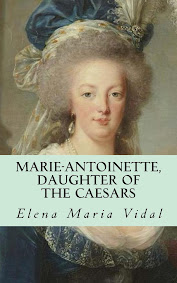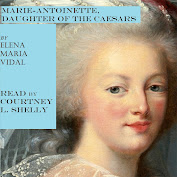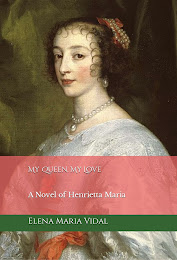skip to main |
skip to sidebar

On the opposite wall, gazing rather sadly at the portrait of the Duc, was a Vigée-Lebrun original of a lady who bore a marked resemblance to Louis XIV. In Turkish dress, her high, frizzled coiffure artfully stuffed into a turban with long, dark ringlets flowing to her waist, the lady's face glowed with quiet resignation, shadowed only by the melancholy sweetness of her smile....
~ from Madame Royale by Elena Maria Vidal
Since the prologue of Madame Royale opens with a description of the portrait of the Duchesse d'Orléans,
I was delighted to find that Catherine Delors has written a post about the duchess' fascinating life. To quote Madame Delors:
Yet the story of Adélaïde began in a very ordinary fashion, insofar as the destiny of a princess can be deemed ordinary. Of the eight children of her parents, she was the only daughter to survive to adulthood. Her father was the Duc de Penthièvre, grandson of Louis XIV and Madame de Montespan. Her mother was an Italian princess, Marie Thérèse Félicité d'Este-Modène. Her only surviving brother, the Prince de Lamballe died at the age of twenty, leaving a young widow who would become one of Marie-Antoinette's closest friends.
This left Adélaïde, known as Mademoiselle de Penthièvre, the sole heiress to the largest fortune in France, and one of the most marriageable princesses of her time. As fate would have it, her father, when she was sixteen, arranged a match with another member of the royal family, Louis-Philippe d'Orléans, Duc de Chartres. The wedding was duly celebrated in the Royal Chapel of Versailles.
The young couple settled in the Palais-Royal, in the heart of Paris. And they had many children (six in eight years.) Were they happy? Not quite. Adélaïde's husband, now Duc d'Orléans, was a libertine who found his lovely bride very boring. He preferred the company of many mistresses, including the infamous Comtess de Genlis, by whom he had an illegitimate daughter named Paméla. Unfortunately not a unusual occurrence for princely and aristocratic marriages in the 18th century.
Share


















7 comments:
She resembles Grace Elliot, possibly it is the pose.
Richard
Oh, dear. I don't think they resemble each other at all.
I have to agree with Elena, Richard! Sure, Grace Elliot was one of the Duc d'Orleans's mistresses, but that is the only connection I see between these two ladies. Grace had a very elongated face and neck (her portraits slightly remind me of Murnau's Nosferatu) and quite a different expression.
Many thanks for the link, Elena!
Sorry, Richard, you are overruled! ;-)
Thank you, Catherine, for such an interesting post!
Once again! Shall I ever learn to leave things distaff alone?
Richard
Unfortunately, that link seems to be broken, but this one works:
http://blog.catherinedelors.com/adelaide-de-bourbon-penthievre-duchesse-dorleans-a-revolutionary-romance/
I feel sorry for this lady; in addition to having to deal with her scoundrel of a husband, and living through the perils of the Revolution, she became estranged from her children, with whose liberal views she disagreed. And then, two of her sons died young, after imprisonment. I recall reading (in one of the books about her daughter-in-law, Marie-Amelie) a sad account of her death; she was murmuring: "My poor children..." It seemed quite poignant.
Thank you, Matterhorn, I fixed the link!
Post a Comment